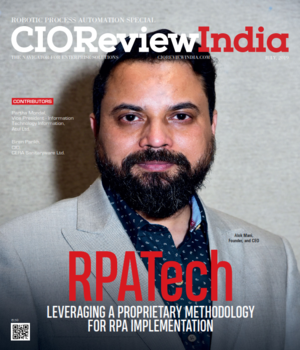
Robotics Process Automation & Artificial Intelligence - Bots & Beyond
Vineet Aggarwal, Head IT, SRL Diagnostics

The world is on the brink of a profound transformation with the emergence of applications that automate processes and help realize organizational benefits either in revenue generation or cost optimizations or employee productivity or quality improvements.
In multiple industry sectors, rules-based, routine, repeatable or predictable business processes have been subjected to increasing degrees of automation. The ever-expanding universe of Artificial Intelligence (AI) is creating lot many opportunities to not only increase the degree of automation but also to apply greater intelligence and cognitive understanding to workflows and processes. While Robotics Process Automation has been around for some time now, but the recent advancements in its usage has created a confusion and deciphering the difference between the two or its co-existence has become a challenge.
So, what leads to the confusion? One reason is that the use cases for RPA, so far, haven’t been that “intelligent”. RPA has always been thought of handling a mundane and a repetitive task but doesn’t learn on its own. Whereas now many technology specialists believe that both these technologies work hand in glove, just like knowledge-based workers and service-based workers collaborate to drive organizational productivity.
Essentially, the two technologies can support each other and work in tandem to form a more robust platform “intelligent automation”.
"Coming from a Healthcare Industry, I believe there are multiple benefits attached with this convergence, while every organization can look through the benefits according to their organizational needs"
Coming from a Healthcare Industry, I believe there are multiple benefits attached with this convergence, while every organization can look through the benefits according to their organizational needs. Sharing some sample use cases below.
1. Extract structured and unstructured data using AI powered document extractors and pass it on to RPA bots to automate end to end processes, reduce human intervention and fast track your processes lowering turnaround times (TAT) and quality issues (read human errors).
2. Improve productivity of Customer Support by relieving them from mundane and repetitive tasks that involves replying to emails, social media feedbacks, voice assistants etc. where bringing RPA and Natural Language processing (NLP) will minimize human intervention.
3. Similarly using Chatbots with RPA can help automate end to end processes, where chat bots help answer general FAQs, provide right information and RPA can take over with the output to complete the subsequent tasks.
The overall approach should be to expand the reach by convergence of technologies, and I am sure when this convergence will mature, we will run upto a new boundary of strategic thinking.
CIO Viewpoint
Gen AI: Transforming Cloud Solutions for...
By Matt Yanchyshyn, VP - AWS Marketplace & Partner Services, AWS
Upcoming Technological Advancements in Payments...
By Pinak Chakraborty, CIO of Airtel Payments Bank
Shaping the Future of AI: Talent, Innovation,...
By Yann LeCun, Chief AI Scientist at Meta
CXO Insights
How RPA is Revolutionizing the Manufacturing...
By Rajeev Soota, VP-IT, Usha International
Optimising Test Instrumentation with Robotic...









